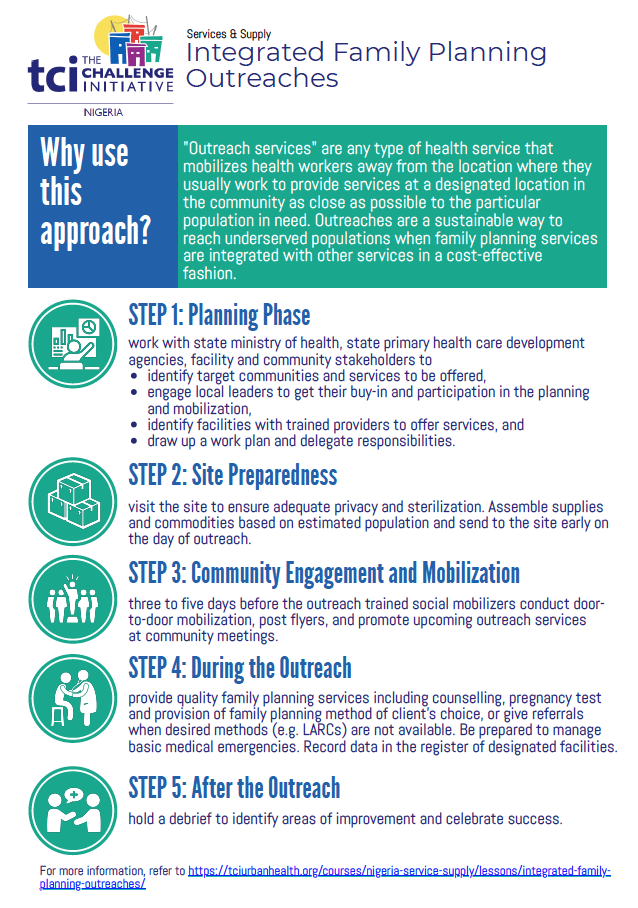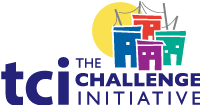Nigeria Toolkit: Services & Supply
- Home
- Help and Support
- Close
- Toolkits
- Global Toolkit
- AYSRH Toolkit
- Hub Toolkits
- Core High-Impact Practices
- Gender Essentials Mini Course
- Close
- Resource Collection
- Community of Practice
- Coaching
- Log In/Register
- My Profile
- English
Integrated Family Planning Outreaches
What is it?
 The term “outreach services” is used to describe any type of health service that mobilizes health workers away from the location where they usually work to provide services to a particular population in need at a designated location in the community as close to the people as possible.
The term “outreach services” is used to describe any type of health service that mobilizes health workers away from the location where they usually work to provide services to a particular population in need at a designated location in the community as close to the people as possible.
Outreaches are not limited to family planning services and did not start with it; however, outreaches have found tremendous application as they enhance access to family planning services by both urban and rural dwellers. Every potential family planning client can be reached through a well-planned family planning outreach.
Initially intended to increase access to family planning services for low performing health facilities, outreaches now serve as sustainable means for reaching the underserved populations when performed in an integrated cost-effective fashion. The integration with other services offers opportunity for clients to access family planning services in the continuum of other integrated clinical services.
What Are the Benefits of This Approach?
- Eliminates missed opportunities caused by distance and other barriers to accessing services at the health facility and ensures that women and their partners can access the family planning methods they desire and in close proximity to their residence
- Provides real-time linkages between community mobilization of clients and service provision by eliminating the time lag between referrals and completion of referrals which often that leads to referrals not being completed
- Serves as an avenue for a robust referral system when the method of choice is not available at the site of the outreach
- Integrated family planning outreach is a cost-effective way of providing integrated services to underserved urban poor and rural communities
- Helps to bring services to the doorsteps of people who are scared to visit health facilities and hospitals, especially during the COVID-19 pandemic
- States are very familiar with this approach; outreaches are largely state-funded and state-driven, therefore sustainable
How Have TCI-supported Geographies Operationalized This Approach?
- In Taraba and Bauchi states, the health facilities already have a robust structure for routine immunization outreaches. Therefore leveraging onto this, TCI supported government to integrate family planning into the already existing outreach programs. First, an orientation meeting was organized for relevant stakeholders and participants with technical assistance from TCI. Key stakeholders included Director Primary Health Care (DPHC), State Reproductive Health/Family Planning Coordinator and relevant local government (LGA) Family Planning Coordinators. Then, TCI coached service providers and LGA Family Planning Coordinators on how to plan for family planning services within existing outreach programs, like maternal, newborn and child health services (MNCH) and immunizations. This includes coaching on effective strategies for integration including integrated health talks and counseling that covers MNCH and family planning and providing family planning service provision alongside other MNCH services.
- At the same time, state and LGA Health Educators, with TCI coaching support, train social mobilizers to mobilize people for family planning services ensuring collaboration between service providers and social mobilizers. All integrated family planning outreaches are linked to strong community-based social mobilization, ensuring high levels of community endorsement and support and complemented by partnership with religious and traditional leaders in TCI-supported LGAs.
What Are the Steps for Implementing This Approach?
Step 1: Planning Phase
State ministry of health and state primary health care development agency teams collaborate and work with relevant facility and community stakeholders to identify the communities and services to be offered during the integrated outreaches. This includes:
- Identifying target communities that need to be reached: what areas have low access to services and what types of services should be made available through outreach? The services most effectively integrated for outreaches are services within the reproductive, maternal, newborn, and child health (RMNCH) continuum, such as immunizations, antenatal care, child health, and family planning services, like we see during state- and donor-sponsored MNCH weeks in the states.
- Engaging relevant community and religious leaders across identified communities and getting their buy-in to be part of planning and mobilization of people for the integrated outreach.
- Identifying focus facility(ies) that will support and report the outreach program. The facilities must have trained providers who can offer quality family planning services.
- Drawing up a work/session plan and allocate responsibilities to the staff and team members.
Step 2: Site Preparedness
Facility management team and the FP Supervisor & Health Educator from the LGA:
- Liaise with community members to identify appropriate locations for the outreach.
- Visit the selected outreach site to ensure logistics and adequacy of the location, e.g. space provides adequate privacy for clients, cleanliness and infection prevention and safety needs, such as , sterilization material and equipment, couch and sitting area to ensure easy flow of clients. Often used locations in the state include schools, traditional palaces and town halls.
- Use estimated population to assemble supplies and commodities.
- Send all commodities and supplies with the outreach team to site early on the day of the outreach.
Step 3: Community Engagement and Mobilization
Trained social mobilizers coordinated by the LGA Health Educator:
- Conduct client mobilization and sensitization three to five days days prior to the outreach day(s).
- Social mobilizers may conduct door-to-door mobilization activities, distribute and/or post flyers and posters and provide information at community meetings about upcoming outreach services.
Step 4: During the Outreach
The outreach team with support from the FP Supervisor from the LGA:
- Provides quality family planning services to clients as they show up at the outreach venue. Services must include appropriate counselling, pregnancy test and provision of family planning method of client’s choice.
- If the client chooses an injectable: Following the procedure, service providers give clients detailed instructions on how to care for the insertion site, back-up contraception where required and schedule a follow-up visit.
- Where the desired methods are not available (usually the case with long-acting reversible contraceptive methods (LARCs)), clients are given referral cards to visit the nearest facility.
- Ensures emergency preparedness. Outreaches offer multiple health services and as such outreach teams need to be prepared to manage basic medical emergencies.
- Record outreach data in the register of designated facilities which usually is the closest facility to the point of the outreach site for easy referrals and repeat visits by the clients.
Step 5: After the Outreach
- Hold debrief meeting with technical team to review the outreach, identifying areas of improvement and celebrating successes.
Key Learnings
- Integrated outreaches are more cost-effective than stand-alone family planning outreaches.
- Integrated outreaches are a one-stop shop for health services especially for mothers and children.
- Adolescents and youth are easily reached through integrated outreaches since they do not have to walk into health facilities.
- Integrated outreaches are more effective in promoting the uptake of Short-Acting Reversible Contraceptives (SARC) than LARCs because of the challenges of getting a sterile environment for LARCs.
- Integrated outreaches are most impactful when conducted in areas that are undeserved with clear need for services.
- Organizing integrated outreach close to a facility (within 5km) will encourage clients who are referred to complete their referrals.
Challenges to Be Aware of
- Integrated outreaches are not very effective for provision of LARC services because of the sterile environment needed for safe provision of services. As a result, a strong referral system is important.
- Problem of recurrent stock out of commodities and supplies. As a result, it is critical that the facility that will be sponsoring an integrated outreach plan accordingly and forecast their commodity and supply needs with the number of outreaches planned in mind.
- It may not be safe for potential clients and service providers to gather in a central gathering spot for integrated outreaches in insecure locations where violence and banditry have taken place.
- COVID-19 protocols must be observed, which may be more challenging to enforce in a community-based setting.
- Data from integrated outreaches are not often separately reported. As a result, it is important the the FP Coordinator and facility staff know when outreaches have occurred so that they can review the data with these events in mind.
Supporting Evidence

Source: PMIS, 2020 – 2021

Source: PMIS, 2020 – 2021
Under What Circumstances Should an Integrated Outreach Be Planned Versus an In-reach?
- Indications for an integrated family planning outreach include inadequate access to family planning services or problems with accessing health facilities, high unmet need for family planning in hard to reach and underserved communities and existing opportunities for leveraging on MNCH outreaches within focus communities, for example.
- Some of the indications for in-reaches include low client turnout or patronage for family planning services, high rate of incomplete referrals for family planning services from the communities and high unmet need for LARC services, among others.
TCI APP USERS PLEASE NOTE
You will only receive CERTIFICATES by email – when earning a score above 80% – and will not be able to view or print a certificate PDF from the TCI app.
Test Your Knowledge
Earn a Certificate
Quiz Summary
0 of 5 Questions completed
Questions:
Information
You have already completed the quiz before. Hence you can not start it again.
Quiz is loading…
You must sign in or sign up to start the quiz.
You must first complete the following:
Results
Results
0 of 5 Questions answered correctly
Your time:
Time has elapsed
You have reached 0 of 0 point(s), (0)
Earned Point(s): 0 of 0, (0)
0 Essay(s) Pending (Possible Point(s): 0)
Categories
- Not categorized 0%
- 1
- 2
- 3
- 4
- 5
- Current
- Review
- Answered
- Correct
- Incorrect
-
Question 1 of 5
1. Question
Outreaches refer only to family planning health services provided by health workers outside of the health facility, in a location closer to the people in the community.
CorrectIncorrect -
Question 2 of 5
2. Question
Steps in planning an outreach include:
CorrectIncorrect -
Question 3 of 5
3. Question
Integrated outreaches are most effective in the provision of long-acting reversible contraception.
CorrectIncorrect -
Question 4 of 5
4. Question
How useful did you find the information and/or tools presented on this page? Please write your response in the box below using one of the following phrases: Very useful, Useful, Somewhat useful, Not useful.
Feel free to comment on why you made that choice.
-
This response will be awarded full points automatically, but it can be reviewed and adjusted after submission.
Grading can be reviewed and adjusted.Grading can be reviewed and adjusted. -
-
Question 5 of 5
5. Question
How do you intend to use the information reviewed and/or tools that you accessed?
-
This response will be awarded full points automatically, but it can be reviewed and adjusted after submission.
Grading can be reviewed and adjusted.Grading can be reviewed and adjusted. -




